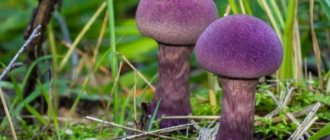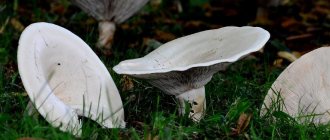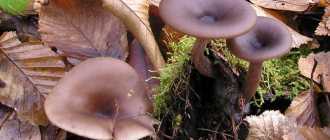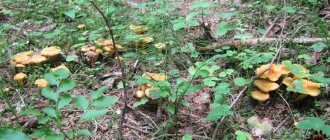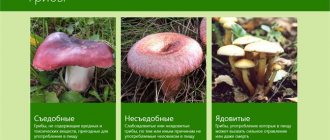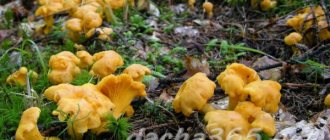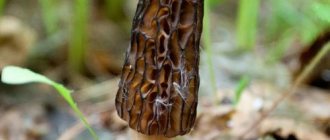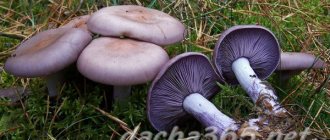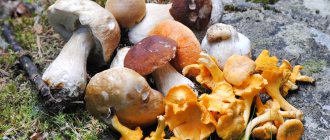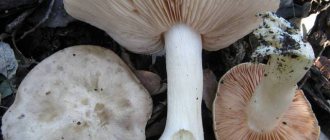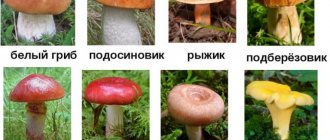General differences between edible and inedible mushrooms
The main difference between poisonous mushrooms and safe ones is the presence of toxins in them. They are divided into three main groups:
- Local toxins. They provoke various disorders of the digestive system, sometimes leading to death. Such substances are found in russula, variegated and yellow-skinned champignon and false puffball.
- Neurotropic toxins. They have a strong effect on the nervous system, the very first symptoms are the appearance of hallucinations, loss of consciousness and severe upset of the digestive system. A similar effect can be caused by fly agarics, talkers and rows
- Plasmotoxic toxins. Mention should be made here of stitches, lobes, bordered gallery and orange-red webwort.
Local toxins
Neurotropic toxins
Plasmotoxic toxins
Based on the appearance of the mushroom, one can make assumptions about its toxicity. Bright coloring is most often found in harmful specimens; insects and worms are also rarely found on such mushrooms. The peculiar skirt is characteristic of edible mushrooms rather than poisonous ones.
If you are not sure that the mushroom is edible, you can make a small cut: if it has turned beige or brown, then most likely the fruit is edible, but if it has acquired a bright color, then you should not take such a specimen.
Most edible mushrooms have a pleasant aroma; you should be wary if there is a chlorine or medicinal smell. If the mushroom cap is very sticky to the touch, then the specimen may be dangerous.
Some varieties of poisonous mushrooms have a sticky cap.
If, based on the signs listed above, the origin of the mushroom remains unclear, you should not take it. In addition, there are many exceptions to these rules.
Ways to determine the edibility of a mushroom
There are many ways to determine the likely harm of a mushroom to human health. However, not all of them are actually effective.
Recognition by plate color
There is an opinion that if a mushroom has pink plates under its cap, then it can be eaten without fear. Indeed, edible champignons have such a feature. However, such plates can also be seen in harmful entolomas.
The pink color of the subcap plates may indicate the harmlessness of the mushrooms
Recognition by fault
If, in the event of a break, the flesh has acquired a white, gray, beige tint or has not changed color at all, then most likely the mushroom is safe. However, the opposite does not mean that the fruit is poisonous. For example, edible hornbeams turn purple when damaged, and hornbeams turn blue.
If the color of the pulp on the break changes color, then there may be poison in the mushroom body
By smell
This criterion is generally quite dubious: not every person has an exceptional sense of smell capable of distinguishing the subtleties of the aromas of mushrooms; often poisonous mushrooms do not have a specific unpleasant odor, but smell exactly the same as ordinary champignons.
What do insects tell you?
They say that if insects or traces of the presence and activity of worms are observed on the fungus, then the fruit is harmless. But this is not at all true, because many living organisms are not susceptible to the toxic effects of these poisons. And such valuable specimens as chanterelles and Polish mushrooms often remain untouched by worms.
Insects can live in both edible and poisonous mushrooms
Silver check
Another folk method is to dip a silver object in water while cooking mushrooms. If it turns black, the dish should not be eaten.
However, such a reaction occurs due to sulfur in the composition of amino acids, which, in turn, are found in both poisonous and harmless fruits. There is a whole subspecies of dangerous mushrooms that cannot be detected in this way.
The method of determining the toxicity of mushrooms using silver is ineffective
Boiling
Some people think that in the process of many hours of boiling, poisonous mushrooms can become harmless. But this is not at all true: most poisons have the property of heat resistance.
Checking with garlic and onions
Often, a head of onion or garlic is dipped into a container. If it darkens or turns blue, it is assumed that the dish is poisonous. But this is due to the presence in mushrooms of a special pigment, tyrosinase, which is found in both harmful and harmless specimens.
Identifying poisonous mushrooms using garlic or onions is an erroneous method that should not be relied upon
Milk test
Sometimes mushrooms are dipped in fresh homemade milk to test their edibility. If it turns sour, then the fruits cannot be eaten. But here again it’s a matter of enzymes: pepsin and organic acids in the composition of any mushrooms are the cause of this reaction.
Vinegar test
This method, unlike the previous ones, takes place. If you boil mushrooms in a solution of vinegar and salt, you can neutralize weak toxins, for example, in the lines.
After such a procedure, pale toadstools will still be dangerous.
You can neutralize some mushrooms by boiling them in salted water with the addition of vinegar.
Poison indicators
Why are there no indicators of mushroom poisons? The fact is that each poisonous species contains different harmful substances that have different effects on the human body. For this reason, it is impossible to recognize such different poisons using a single “indicator”.
Singing mushrooms: how a tiktoker made oyster mushrooms play a synthesizer
View this post on Instagram
A post shared by Noah (@mycolyco)
Meet Noah. He lives in North Carolina and has been writing music for many years. But this is not his only hobby - recently Noah began growing mushrooms. When the pandemic hit, he was left without work and initially decided to create his own “mushroom-related” business.
At one point, the room where Noah composed music also turned into a real farm, where oyster mushrooms and even cordyceps grew - a mushroom that turns insects into zombies. And suddenly the musician had an idea: what if you combine your two hobbies?
Noah remembered reading that signals passed through organisms can turn into sounds, and set to work. Even before the pandemic, he worked in the production of modular synthesizers and in theory understood how all this could be done. And in electrical engineering, self-taught Noah always crashed well.
At first, the musician wanted to play big and create a biodata sonification module from scratch with his own hands - that’s what this tricky process is called. But growing mushrooms took too much time, and in the end Noah “agreed” to a ready-made device.
“Roughly speaking, biodata sonification uses the same technology as lie detectors. A small current is passed through the subjects and resistance or impedance is measured. The difference in resistance is then converted into signals that can be used in music. I can configure a modular synthesizer so that these signals control what sound to play, its pitch and timbre, and how long it will play."
Each mushroom sounds different - Noah attributes this to the stage of growth and the amount of water. Moreover, if you change the location of the electrodes on the same mushroom, you can end up with completely different music. And long and voluminous myceliums provide more space for a variety of sounds - mushrooms with small mycelium have a much more modest media library.
However, not just mushrooms - Noah also connects different crystals to the synthesizer. It just so happens that his wife has her own store where they are sold. And in this area, the mushroom picking musician considers himself a pioneer.
“When I was about ten years old, I dreamed that crystals would begin to glow if they were wrapped in wire and connected to a battery. I begged my parents to buy me a battery holder, alligator clips, and wire. They gave in to persuasion, but when I connected everything to the quartz crystal, of course, nothing happened. But I remembered this story 20 years later, when I decided to connect crystals to a synthesizer."
To make the crystals “sing,” Noah wrapped them with wire and, in fact, connected them to the synthesizer. Taught by experience, he understood that something should work out, but he never expected such a result. Crystals - non-living solids (!) - have indeed gained a “voice”.
@mycolyco
##crystals playing ##synths close your eyes and ##meditate ##rosequartzoriginal sound - Noah
Even after some time, Noah does not fully understand what exactly creates the impulses in the crystals - whether they appear on their own, or whether the wire works as an improvised antenna and catches some signals. At the same time, all crystals sound differently, and if you surround the “soloist” with other stones, the melody may also change.
Noah's music, of course, doesn't yet sound like something you can add to your playlist and listen to on your way to work. However, natural electronic tunes are great for meditation. At least Noah himself is sure of this. And he advises listening to his melodies “very carefully” - only then will the desired effect appear.
“To be honest, I’m not sure that there is that much of a difference between the practice of “deep listening,” as Pauline Oliveros described it, and meditation. I think “deep listening” is a useful tool for shaping melody and making the listener’s connection with the music stronger.”
And in general, there’s more to come. In the near future, Noah plans to experiment with music samples. Perhaps he will be able to teach mushrooms to imitate - to reproduce not just sounds, but his own voice or some classical music. This requires a new technical module, a lot of patience and a little luck.
Noah also has a goal - to make creativity his main source of income. The musician, mushroom picker, and electrical engineer has already begun to master social networks in order to tell his subscribers about himself. Two weeks later, Noah even got a Patreon sponsor (and he's very proud of it). But still, for the music and mushroom industry, this is just the beginning.
Author: Egor Tishin
Author: Elizaveta Parshina
Subscribe to the RTVI telegram channel
How to perform a control check
In addition to the fact that you need to carefully select mushrooms in the forest, you should also check them when you arrive home. They cannot be stored raw, so they will have to be washed, peeled and cooked right away. It is during cleaning that a control check should be carried out and not only supposedly poisonous mushrooms should be excluded, but also old specimens that can also become dangerous.
The most proven way to determine edibility is a thorough visual inspection.
Types of mushrooms
All types of these amazing forest organisms are divided according to the degree of edibility and taste.
According to the degree of edibility, mushrooms are divided into the following categories:
- edible;
- conditionally edible;
- inedible;
- and poisonous.
Representatives of the first two categories - edible and conditionally edible - are divided into 4 more categories, but according to taste:
Category 1: only edible mushrooms belonging to it (category 1 of edibility) can be consumed raw, without fear for health (champignons, russula, etc.). Porcini mushrooms, boletus mushrooms, aspen mushrooms, etc. are considered the most delicious. They are easy to clean and quick to cook. All qualities are preserved when frozen or dried.
Category 2: saffron milk caps, boletus, Polish, chanterelles, etc. - tasty and popular, but do not have such a bright aroma. It was this feature that sent them to the 2nd taste category. They make excellent soups, hot dishes and salads.
Category 3: this includes honey mushrooms, morels, oyster mushrooms, etc. They are more suitable for pates and light snacks, with the addition of other vegetables.
Category 4: mushrooms with low taste are included here. It includes conditionally edible varieties of mushrooms: moss mushrooms, milkweeds, mountain weeds, etc. They are soaked for a long time to get rid of the specific bitter taste, boiled for up to 40 minutes and then prepared according to the basic recipe, with the addition of spices to enhance the taste.
Is there a 100% method for determining the toxicity of a mushroom?
No matter how hard you try, you won’t be able to check with absolute certainty whether a mushroom is edible or not. We can only guess with some certainty.
The most reliable distinguishing feature of edible mushrooms is considered to be the presence of a spongy cap structure, which in harmful specimens is found only in the satanic mushroom. As a rule, false representatives are characterized by a lamellar structure.
Most poisonous mushrooms have a lamellar structure
Which method is the most reliable?
Here's what you should do to determine the fate of an unknown mushroom:
- Examine the inside of the cap and recognize its structure: lamellar or tubular. Most poisonous mushrooms are of the lamellar type.
- Inspect the lower part: harmful mushrooms very often have an ovoid-shaped thickening on the stem;
- Identify the presence of a collar ring, usually located in the middle of the stem, a little closer to the cap. Such an element may indicate the danger of the specimen.
Mushrooms with a ring on the stem are usually very poisonous
How to distinguish twin mushrooms
Novice mushroom pickers may confuse edible specimens with their dangerous counterparts. The most famous of them will be described below.
Edible honey mushrooms and false ones
There are very few species of honey mushrooms that are unsuitable for food. False honey fungus has a convex cap of yellowish-red or orange color up to 5 cm in diameter. The leg is long, thin, smooth, hollow and fibrous. The pulp has a light yellow tint, bitter taste and unpleasant odor. Found from June to October.
It is very easy to confuse safe honey mushrooms with harmful ones, because they always grow in groups on stumps, fallen trees and roots rising above the ground. The main difference between edible honey mushrooms is the presence of a plate-shaped cap with a diameter of 3-10 cm. It is convex in shape, with age it opens to a flat one with wavy edges. The skin can be of different shades from brown to green-olive. Covered with light scales.
It is very easy to confuse real honey mushrooms with false ones.
Another sign that you can rely on is a special skirt on a long leg, 8-10 cm in length and about 2 cm in thickness, characteristic of harmless specimens. It is usually yellow-brown in color, darkens to brownish-brown in the lower part, and is covered with flaky scales.
After consuming a poisonous mushroom, the digestive system becomes upset: after a few hours, vomiting, nausea appear, loss of consciousness or an attack of excessive sweating may occur.
Real chanterelles and false ones
False chanterelles have a funnel-shaped cap with a smooth edge that is orange-red or copper-red. The plates are also very bright and sinuous. The leg grows up to 10 cm in length and 0.1 cm in thickness, tapering towards the base. It grows mostly from July to October in a group with true chanterelles.
The edible chanterelle is distinguished by its bright yellow color and the wavy, thick and blunt edge of its fleshy cap. Its stem is much darker than the cap, full and thick, but quite short. The fruit also has a pleasant fruity aroma.
External signs of the difference between false chanterelles and real ones
Another striking difference is the pleasant smell of the white or yellow pulp. On the cut it may turn blue, red or not change.
False and edible boletus
Edible boletus is characterized by an oily, slippery hemispherical cap from 3 to 14 cm in diameter and a stalk of a similar structure. The brown or red-brown skin is extremely sticky, this property increases several times after rain. It is easily separated from the whitish or yellowish soft pulp. The cap has a spongy structure, it can be of different colors and depends on the type.
False boletus has a reddish tint to the stem and pulp and a brown, sometimes closer to purple, color to the cap. The spongy layer is rather dark; there is also a characteristic skirt on the stem. When broken or cut, the flesh of the false butterfly turns red or blue, but if it has not changed color, then it can be eaten.
Boletus mushrooms and false doubles
Forest champignon and toadstool
Forest champignons are distinguished by a dry, smooth or slightly scaly round cap with a white or gray edge curved inward, about 8-15 cm in diameter. When pressed, the plates located under the cap darken. The leg grows up to 9 cm in height and up to 2 cm in thickness. It is straight and even, widened towards the base, with a wide white ring. They grow in open places well illuminated by sunlight: on forest edges, along forest roads, in garden plots and near wetlands.
Differences between champignon and toadstool
This famous and nutritious mushroom is often confused with the dangerous toadstool. Unlike champignons, these fruits grow exclusively in deciduous forests. They have a greenish or grayish cap about 15 cm in diameter with a smooth edge and a fibrous surface. When pressing on the plates under the cap, they do not change their color, and the bag-like film at the base of the stem, characteristic of champignons, is not observed at all.
Pale toadstools have an unpleasant, repulsive odor, unlike the pleasantly smelling champignons.
White mushroom (boletus) and satanic mushroom
White has several dangerous doubles. If the boletus mushroom has a beige or white cap, then the false mushrooms may have a brown or red tint. If damaged or broken, the boletus pulp will retain its original appearance and color. But in the satanic mushroom it will slowly begin to acquire a bluish or purple tint.
Also, false fruits will have dark or reddish streaks on the stem.
Differences between the porcini mushroom and its poisonous counterpart
Edible and inedible pigs
Edible pigs grow in deciduous and coniferous forests. They are distinguished by their particularly large size: the circumference of the fleshy olive-brown or olive-brown cap often reaches 30 cm, its wavy edges are slightly curved inward. Its shape resembles an elongated tongue or a pig's ear. The fruit body is very dense, hard, dry and velvety to the touch, brown in color. When damaged it turns dark.
In poisonous specimens, cracks form on the cap, and the flesh has a yellowish tint. They are found in the same places where safe pigs grow.
Pig mushrooms are representatives of a group of conditionally edible mushrooms
False and real boletus
Poisonous boletuses are distinguished by a darker cap and also a blue cut or fracture. It is also believed that false boletuses are not found just under birch trees.
The main distinguishing features of false and true boletuses
Real and false russulas
This is the same mushroom that grows in almost any area. His hat can take on completely different shades: pink, red, yellow, brown, green. However, the color will always be uniform, without any spots or dots. The skin is easily removed, and the white leg breaks quickly and easily.
False russula have denser, harder and more elastic flesh of a pinkish color. There is a reddish dark soft film on the stem, and spots and dots are observed on the cap. Another striking distinguishing factor is the unpleasant taste with strong bitterness.
The main difference between edible russula and poisonous one is the color of the cap.
Mushroom places
A mushroom map of the region shows where it is best to look for certain species, depending on the season.
Near the city, within its boundaries, where there are many industrial enterprises, landfills and busy highways, it is better not to take mushrooms. They may be hazardous to health. It’s better to go to Lebyazhye Lake, in the Zelenodolsk region, and collect a lot of boletus and saffron milk caps. After the rains, a lot of boletus and aspen mushrooms are traditionally collected in these parts.
- Vysokogorsky region: the soil here is especially fertile. Therefore, near the village of Kamenka there are many boletuses and honey mushrooms.
- Arsky region, mixed forests: famous for their hemp mushrooms, boletuses and boletuses.
- Laishevsky district, village of Stolbishcha: behind it, in the forest, mushroom pickers prefer to collect milk mushrooms, moss mushrooms and boletus mushrooms.
- Kirovsky district, Zaimishche village: behind it are the best places for collecting full baskets of milk mushrooms, chanterelles and honey mushrooms.
- Sovetsky district: it is distinguished by its diversity and the presence of a huge number of mushroom places where boletus mushrooms, white milk mushrooms and white mushrooms are collected. If you get further into the bowl, it’s easy to collect a lot of honey mushrooms on old stumps.
Where not to collect
On the territory of the Volzhsko-Kama Nature Reserve, near Raifa, you cannot collect mushrooms. All plants and other living organisms in this area are protected by law. Mushroom picking is also prohibited in the Sviyazhsky State Nature Reserve, because many of them are rare and listed in the Red Book.
Information for beginner mushroom pickers
If you have the opportunity to go on your first trips to the forest in the company of experienced mushroom pickers, it is better to take advantage of it. An expert will be able to answer questions that arise during the collection process, dispel doubts about specific specimens and suggest effective methods that will help you understand how to distinguish poisonous mushrooms.
When going to the forest, special attention should be paid to the correct and reasonable selection of clothing. It should not restrict movement, but should reliably protect the body and skin from various insects. Shoes should also be closed, without any additional holes: flip-flops and sandals should be put aside for another occasion. A headdress will come in handy: you can use a cap, hat or scarf.
Proper equipment for a mushroom picker
It is recommended to collect in special baskets, which are made from pine shingles, birch bark or wicker. You should not take buckets and containers made of plastic or plastic and plastic bags with you, especially if you plan to collect redheads, boletus and boletus - in such containers they will wrinkle and break.
You definitely shouldn’t pick mushrooms within a radius of 500-1000 m from roads and busy highways. This is due to the fact that mushrooms are characterized by increased sensitivity to harmful substances, toxins and heavy metals that they accumulate in themselves. Such harmful substances certainly cannot be neutralized using heat or heat treatment.
Poisoning can lead to serious and severe consequences, including death. A separate risk category includes children, the elderly and pregnant women. On average, symptoms of poisoning begin to appear 2 hours after eating the fruit. Symptoms are similar to other types of food poisoning: diarrhea, vomiting, severe abdominal pain and general weakness.
Signs of poisoning from poisonous mushrooms
If the above symptoms occur, you should immediately call an ambulance. While waiting for medical workers to arrive, you need to perform gastric lavage, take activated charcoal, stay in bed and drink plenty of water or strong tea.
It may also be helpful to save any remaining cooked mushrooms that may have caused poisoning. This will make it possible to make a diagnosis faster and more accurately.
Is it possible to get poisoned by edible mushrooms?
Sometimes even eating proven mushrooms can lead to poisoning. This may happen for the following reasons:
- Bacteria. If they enter the nutrient medium of the mushroom body, they begin to multiply intensively. Sources of infection can be soil, transportation containers, even unwashed hands. If the fruits are not properly processed, then when consuming them, you can get bacterial poisoning. However, all these bacteria die after heat treatment. But improper pickling, in which the fruits were kept in the same water for a long time at an elevated ambient temperature, or in which no salt was added, can be dangerous.
- Botulism. This can occur with canned foods due to clostridia spores. If pickled mushrooms are stored indoors without access to air, then they may become contaminated.
- Toxins. Mushrooms, like sponges, absorb all the chemicals around them. Therefore, heavy metals and herbicides that get into fruits growing near agricultural lands or industrial zones also enter the human body, causing severe poisoning.
Homemade canned mushrooms can cause botulism
The digestive system has difficulty digesting heavy mushrooms, so they should be eaten in moderation. And people who have problems with the gastrointestinal tract, kidneys or liver should avoid using this product altogether.
Proper preparation is a guarantee of safety
In order to eat conditionally edible types of mushrooms without fear of poisoning, you should learn how to cook them correctly. This applies to the preparation, in particular, of autumn mushrooms, white and black milk mushrooms and spring morels.
A mandatory step is long-term heat treatment. You will need to cook for 40 minutes, then get rid of the water in which the mushrooms were cooked and rinse them thoroughly. After such a strong treatment, all useful substances, including proteins, are preserved. They only get rid of harmful substances that can spoil the taste of the pulp.
Heat treatment eliminates the bitterness and toxicity of mushrooms
Why you can’t destroy poisonous mushrooms
But it is impossible to destroy and exterminate poisonous mushrooms, otherwise this can cause serious harm to the ecosystem and seriously upset the balance of nature. Many spongy and lamellar species that are dangerous for consumption can be used in the treatment of artiodactyl wild animals. Also, these specimens can be used for medicinal purposes by people. For example, such mushrooms help in the treatment of rheumatism, various nervous and mental disorders, lung diseases, oncology and other pathologies.
Alcohol is not a cure for poison
An alcoholic drink will not only not help, but will also worsen the person’s condition. The fact is that alcohol provokes an accelerated movement of toxic substances in the body, which is why the poison begins to act faster.
It is not recommended to combine mushrooms with alcohol, as it enhances the negative effects of mushroom components on the body.
Misconceptions about recognizing edible and poisonous mushrooms
There are many folk signs that supposedly can help in identifying poisonous mushrooms, however, many of them are wrong. Here are some of them:
- It is believed that the poisonous fruits have a very unpleasant taste. This is not true, fly agarics have a pleasant taste. And you shouldn’t carry out such experiments, because they can lead to severe poisoning. It is necessary to learn to recognize mushrooms solely by their appearance.
- Young poisonous mushrooms are not dangerous, but the poison accumulates with age. This is also not true; young specimens are no less dangerous, especially for pale grebes.
- Dangerous mushrooms have an unpleasant odor. This is only partially true, but there are entire categories that have a pleasant aroma or almost no smell.
In some cases, you can identify a poisonous mushroom by smell.
Picking mushrooms is a very delicate matter that requires serious preparation, otherwise you may end up in the hospital with a gastrointestinal disorder. Therefore, you should carefully study the differences between harmful and dangerous mushrooms. Even experienced mushroom pickers can make mistakes, but they will not put an unknown and dubious mushroom in the basket.
How do you distinguish edible mushrooms from inedible ones? Share your experience with newcomers in the comments.
The season does not end, or where to look for mushrooms in the Leningrad region in the fall of 2022
For some, the mushroom season has already ended, but for others it has just begun. Residents of St. Petersburg and the Leningrad region continue to comb the forests - as a result, full baskets and buckets of harvest.
Online47 looked at which places in the Leningrad region you can find mushrooms this fall, and was also pleased with the photographs of someone else’s “catch.”
Anna Krupskaya/vk.com/grib_spb
Are there mushrooms in the Leningrad region now?
The abnormal summer is behind us, as is the abnormally cool September. Until October 10, weather forecasters predict an Indian summer in St. Petersburg and the Leningrad region, so many went for the mushroom harvest.
Do not miss
Forecast for October: what to expect from the weather in the Leningrad region and St. Petersburg
Heavy rains in September had a positive effect on the autumn harvest. In the forests of the Leningrad region there are porcini mushrooms, boletus mushrooms, black milk mushrooms, and chanterelles with saffron milk caps. A great gift for mushroom pickers who celebrated their professional holiday the day before.
Svetlana Arkhipova/vk.com/grib_spb
It was expected that the 2022 mushroom season in the Leningrad region would not be very good when compared with last year. However, mushroom pickers hoped for the best: their expectations were justified.
“Happy wonderful holiday to all mushroom pickers! I wonder why mushroom picker’s day is only in October?” – asked Natalya Litvinenko in the VK community “Mushrooms and Mushroom Pickers of St. Petersburg”.
World Mushroom Picker Day is celebrated annually on October 3. And although it is not marked in any calendars, it is a holiday for lovers of “silent hunting”. And it is celebrated in October, because this is the height of the mushroom season.
Svetlana Smirnova/vk.com/grib_spb
Honey mushrooms are a special boom this fall. These mushrooms grow at cosmic speed, as residents of the Leningrad region admit. Anyone who has not yet visited the forest is advised to do so now.
Olga Solovyova/vk.com/grib_spb
“The forest is simply paradise. The sun, the leaves are spinning. But there are practically no mushrooms,” noted a resident of the Lomonosov district.
But residents of the Priozersky, Gatchina, Vsevolozhsky and Vyborg districts of the Leningrad region will probably not agree with her. This fall they are especially happy with the mushroom harvest.
Alexander Pavlov/vk.com/grib_spb
Alexander Pavlov/vk.com/grib_spb
In general, it’s worth saying that real mushroom pickers never end the season. Some mushrooms are running out, others are just beginning to appear. Therefore, there is no need to worry about the autumn season, because winter and a new harvest are ahead.
Ksenia Bondarenko
Photo: Anna Krupskaya/vk.com/grib_spb

